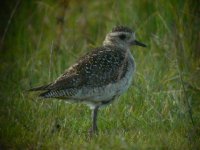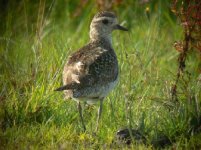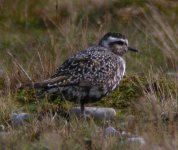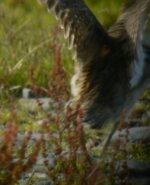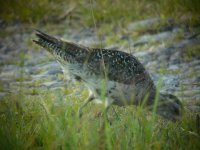-
Welcome to BirdForum, the internet's largest birding community with thousands of members from all over the world. The forums are dedicated to wild birds, birding, binoculars and equipment and all that goes with it.
Please register for an account to take part in the discussions in the forum, post your pictures in the gallery and more.
You are using an out of date browser. It may not display this or other websites correctly.
You should upgrade or use an alternative browser.
You should upgrade or use an alternative browser.
Golden or American Golden (1 Viewer)
- Thread starter Jamspangle
- Start date
More options
Who Replied?
Hmm, I'm not sure this is a juvenile first of all. It seems to show quite a mixture of fresh and worn feathers on the upperparts. I'm finding it hard to call it as anything other than European Golden - it looks rather short legged and the primary projection and tertial length seems okay. I'd expect an adult American Golden at this time of the year to have a lot of black on the underparts but a lot of European Goldens have already lost theirs.
lostinjapan
Well-known member
I'd also go for American Golden Plover, but it has been a long time since I saw one. I can tell you it definitely isn't a Pacific Golden Plover.
For all the reasons already mentioned- long primaries, prominent super, greyish plumage and the tertial pattern I'd say American. Seems a little ittle slimmer and less bulky than Eurasian Golden. Also seems quite small-billed and longer-bodied than the other two species. Not sure long legs is always an American trait, though certainly is for Pacific.
Sean
For all the reasons already mentioned- long primaries, prominent super, greyish plumage and the tertial pattern I'd say American. Seems a little ittle slimmer and less bulky than Eurasian Golden. Also seems quite small-billed and longer-bodied than the other two species. Not sure long legs is always an American trait, though certainly is for Pacific.
Sean
Jane Turner
Well-known member
I think if I saw this I'd be looking at it hard to see what its underwing coverts looked like, but I'd be a little surprised if they are were grey. Its an adult. I'm having trouble making out the tertials - I think its dropped at least one, and I certainly can't see the coarse notching I'd expect on AGP. Adult EGP have corking supercilia in Summer plumage.
I think I'm with Andrew!
I think I'm with Andrew!
Last edited:

Below is an adult American Golden Plover I saw in Lewis in early September last year. Even at that stage, it retained a great deal more of its breeding plumage than the Irish bird shows. On the other hand, I saw around 50 European Golden Plovers on Sunday and most had already lost their black underparts. The Irish bird seems to have retained its summer head pattern to some extent, which is much more contrasting and AGP like. But I can't see this as anything other than a fairly normal moulting adult European Golden Plover.
Attachments
rob stoff
Well-known member
Below is an adult American Golden Plover I saw in Lewis in early September last year. Even at that stage, it retained a great deal more of its breeding plumage than the Irish bird shows. On the other hand, I saw around 50 European Golden Plovers on Sunday and most had already lost their black underparts. The Irish bird seems to have retained its summer head pattern to some extent, which is much more contrasting and AGP like. But I can't see this as anything other than a fairly normal moulting adult European Golden Plover.
but 1st-summer American shows little or no black below. I know Eurasian can show variable wing length but I've never seen one with wings like this and all other observable features fit American very well IMHO. Would be interested to see any pics of July Eurasian that match this bird, i.e. strong contrast between upperparts and underparts (including upperparts with some plain brown feathers), diffusely grey-barred flanks etc.
Rob
Hi Andrew.
Can we really use the state of the birds moult from summer to winter plumage reliably? I mean, they're all going to be different; some with near summer plumage, some with near winter, and some with a mix. Also, aren't induvidual birds going to vary?
Also, would a EGP ever have this much black and this little gold in the plumage?
Jason
Can we really use the state of the birds moult from summer to winter plumage reliably? I mean, they're all going to be different; some with near summer plumage, some with near winter, and some with a mix. Also, aren't induvidual birds going to vary?
Also, would a EGP ever have this much black and this little gold in the plumage?
Jason

Hi Andrew.
Can we really use the state of the birds moult from summer to winter plumage reliably? I mean, they're all going to be different; some with near summer plumage, some with near winter, and some with a mix. Also, aren't induvidual birds going to vary?
Also, would a EGP ever have this much black and this little gold in the plumage?
Jason
I don't think you could use this 100% reliably but it's a very useful guide. I think it would be a very atypical for an adult AGP to look like this at this time of the year. I would expect that most, if not all, would be more-or-less in full breeding plumage. EGP on the other hand would quite typically have lost most of its breeding plumage.
I'm not sure what you mean by 'this much black' - it doesn't look to have very much. And compare with my picture of an AGP. As you say, birds vary and EGPs vary in plumage tone a great deal. Quite grey looking birds are not unusual. This bird also shows a somewhat thicker bill than the AGP in my picture.
I can't see anything much in favour of this being an AGP.
OK. Shant take this any further; you seem to know what your talking about, lol! I've only seen one AGP, and was with a very good birder so I think I learned alot. However, theres still much more to understand, as this shows. Also, I reckon I've forgotten most of what he told me!
Jason
Jason
Jamspangle
Up the boro!
thank you all very much for your thoughts. i have a few other very bad shots i can post if you wish - on one of them a wing is raised and it does appear to be white under there. ill let you know what other people think round here if they see it. thanks again
jamie
jamie

OK. Shant take this any further; you seem to know what your talking about, lol! I've only seen one AGP, and was with a very good birder so I think I learned alot. However, theres still much more to understand, as this shows. Also, I reckon I've forgotten most of what he told me!
Jason
Don't worry Jason - I've not seen a huge number of AGPs myself. I know that there are a lot of pitfalls for IDing one, some of which I've fallen for myself. One is that European GPs sometimes retain the contrasting head pattern, with a whitish supercillium and dark crown, after they've lost much of the rest of their breeding plumage. I think that's what's happening with this bird.
rob stoff
Well-known member
thank you all very much for your thoughts. i have a few other very bad shots i can post if you wish - on one of them a wing is raised and it does appear to be white under there. ill let you know what other people think round here if they see it. thanks again
jamie
would like to see the underwing shot Jaimie!
here's a ref for 1st-s American, albeit earlier in the season:
http://www.rarebirdspain.net/arbsi011.htm
Rob
Jamspangle
Up the boro!
really dodgy photos - but thought they might help clear this up. one of it feeding, to give a better idea of shape, and the only shot i got of it with wings raised - sorry! he only did this once in the hour and a half i watched it.
Attachments
AStevenson
Well-known member
The white on the underwing in the later picsdoes give it away but...given the amount of wear much of the plumage and limited breeding plumage feathers, I wouldn't be surprised if this isn't a 1st summer rather than ad EGP - I've seen birds like this before.
Moult can be quite useful in picking up ad AGP amongst EGP as AGP is a long-distance migrant which tends to moult mostly once it reaches the wintering grounds, therefore ad vagrants in the UK often have much more bredding plumage than the EGPs they often associate with. EGP moults right through from July to Oct, so although you can still get odd ones later in the autumn in breeding plumage the majority are well moulted.
Cheers,
Andrew
Moult can be quite useful in picking up ad AGP amongst EGP as AGP is a long-distance migrant which tends to moult mostly once it reaches the wintering grounds, therefore ad vagrants in the UK often have much more bredding plumage than the EGPs they often associate with. EGP moults right through from July to Oct, so although you can still get odd ones later in the autumn in breeding plumage the majority are well moulted.
Cheers,
Andrew
Users who are viewing this thread
Total: 2 (members: 0, guests: 2)




